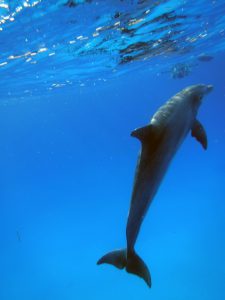
*Ka-chow* The Colonels wake up in a fright! Don’t worry, no murder mystery here, but there was thunder and lots of rain. We were worried that we would have to use up our 2nd weather day, but by about 10:30 the sky seemed pretty much done. So, we had a little excursion back to South Bimini – with the bugs – to the SharkLab! We saw baby lemon sharks with tour guides Sarah and Wajeh. We learned some fun facts, like nurse and lemon sharks are so flexible that they can bite their own tails. Sarah told us that they go into “the donut shape” when they are stressed and they will not release themselves until calm. Lemons, like nurses, can buccal pump so they can breathe even when staying still. It was interesting to compare our experiences so far with the dolphins (Just observe! No touching!) with the techniques at the Lab – they can handle shark species, including tagging. They have different techniques for tagging, depending on the size and species. They study several different species around Bimini and can even ultrasound captured sharks to discover their pregnancies. It’s amazing how many pups they can have at one time. Learning about the PhD’s students’ work at the non-profit Lab is cool too!
Then we came “home,” ate a speedy lunch and got on the boat. Our trip started with a chance to snorkel “Bimini Road” (aka Atlantis or Road to Atlantis). It was really cool. Holly “saw some rocks and stuff!” and others saw lots of cool fish. For most of us, we felt like it was just rocks – making a nice home for fish. Others could see the idea that they are natural rocks that were put there by native communities. No votes from this group that they are remnants of the Lost City of Atlantis.
After our snorkel, we resumed our survey, searching for dolphins. At 16:39 we first saw dolphins – this time, eight bottlenose dolphins! It was pretty easy to spot (ha!) the difference between the species. The bottlenose are so much bigger than the spotteds. And, we could really see what Kel was talking about in the differences between the dorsal fins. One was missing the tip while others had clear nicks and another was bent over! Once the crew determined that the bottlenose were settled in one spot, “crater feeding,” so we were able to hop in!
While observing underwater, we saw the crater feeding – watching the dolphins cruise along the sea floor, then abruptly turn and bury their rostrums in the sand. Watching them pump their flukes to get deeper was cool. There was a calf, and we watched it follow its mom and even nurse! Late in the hour long swim, a nurse shark cruised through the group. One of the dolphins was clearly missing its pectoral fin. At one point, there was more social behavior, with older dolphins making contact with each other and some juveniles practicing their mating techniques. They stayed around for much longer than we expected; at one point we thought they were gone, but suddenly, they were back! They sounded different from the spotteds – with much more buzzing and clicks from their echolocation. When they echolocated on us, we could even feel it. Back on the boat, the carrots were no match for Haley and Sarah (inspired by the bottlenose snacking?).
As we cruised back to the dock, we saw our first spotteds of the day – first, a group of seven and soon after a group eight. Both groups had calves with them and at one point a trio all leapt out of the water together. The first group included Romeo (#10), possibly Tina (#14) and Tina’s calf (to be catalogued). The second group included Leslie (#80). Because it was late in the day, we had to be content with our short boat-based observation of this group – but maybe we’ll see them more tomorrow!
Dinner was pizza (thank you, Edith!) and ice cream for dessert. Tonight’s dinner crew attacked their dish duty!
Until tomorrow,
Roll Kerns (EKU 2019)
